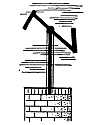 One of the most important developments in visual telegraphy took place
during the French Revolution when Claude
Chappe devised a semaphore
system. These semaphores were erected on high towers about 10 miles
apart, and a message could be sent from Paris to Lille, 130 miles away,
at the rate of about 100 words per hour. An English writer of the time
said, "Telegraphs have now been brought to a great degree of
perfection… The whole kingdom could be warned in an instant of an
approach of an invading army."
One of the most important developments in visual telegraphy took place
during the French Revolution when Claude
Chappe devised a semaphore
system. These semaphores were erected on high towers about 10 miles
apart, and a message could be sent from Paris to Lille, 130 miles away,
at the rate of about 100 words per hour. An English writer of the time
said, "Telegraphs have now been brought to a great degree of
perfection… The whole kingdom could be warned in an instant of an
approach of an invading army."However, long before this, a new Force - electricity - was beginning to make itself felt in the world of science. Almost 200 years ago Benjamin Franklin sent an electric current through a wire stretched across the Schuylkill River, and set fire to alcohol at the other end. Oersted, Sturgeon and Faraday, over a period of years, had uncovered many of the basic principles of electricity and magnetism. In 1831 Professor Joseph Henry strung nearly a mile of wire around one of the rooms in the Albany Academy. By closing a switch at one end of the wire, he could ring a bell at the other. The stage was being set for the electromagnetic telegraph. In 1832 Samuel Morse, a famous artist and President of the National Academy of Design in New York, returning from Europe on the packet ship "Sully" met Dr. Charles Jackson of Boston. One evening at dinner Dr. Jackson mentioned that experiments had shown that electricity possesses the ability to pass instantly over any length of wire. In the course of the conversation Morse said, "I see no reason why intelligence may not be transmitted by electricity." |








